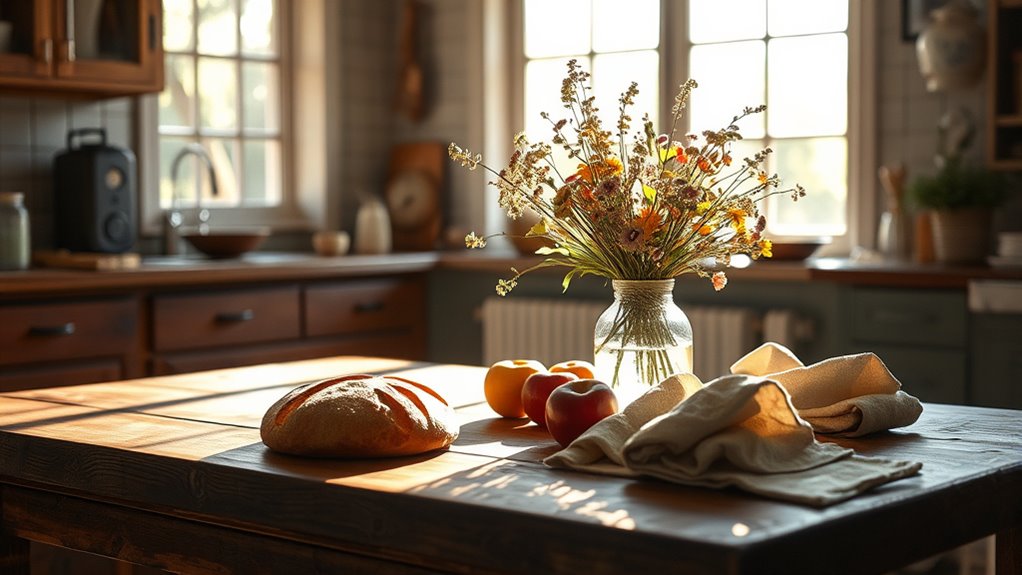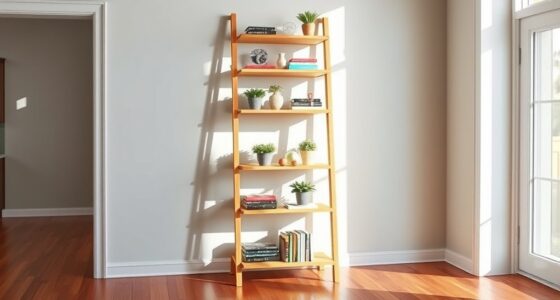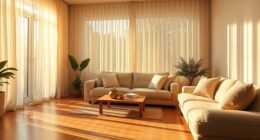Natural light isn’t always better because it can be unpredictable, changing with weather, season, and time of day. Indoor or nighttime shoots often lack enough natural light, making artificial lighting essential for consistent results. Environmental factors like pollution or haze can weaken light quality, while quick weather shifts create challenges for stable exposure. If you’d like to discover more about when and why natural light might fall short, you’re in the right place.
Key Takeaways
- Natural light is unpredictable and varies with weather, time of day, and environmental factors, making consistent results difficult.
- Indoor and nighttime conditions lack sufficient natural light, requiring artificial lighting for proper exposure and control.
- Achieving artistic consistency with natural light is challenging due to rapid changes in brightness and color temperature.
- Limited shooting windows, such as golden hour, restrict natural light use and require quick adaptation to weather shifts.
- Artificial lighting offers reliable, controllable, and uniform illumination, often outperforming natural light in complex or low-light scenarios.
The Unpredictability of Natural Light
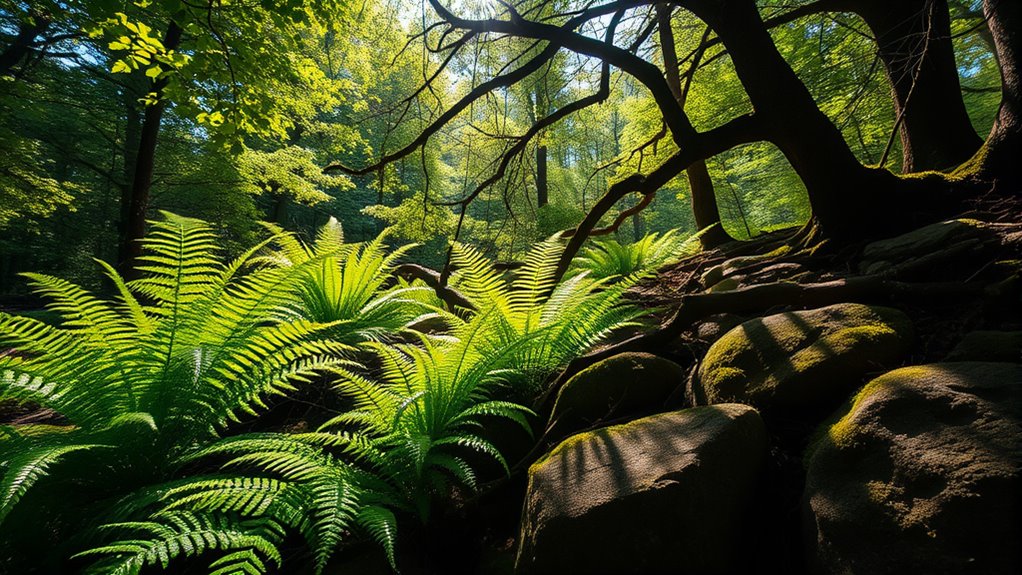
Have you ever planned a photoshoot only to be thwarted by changing weather? That’s the unpredictability of natural light at work. Weather conditions, cloud cover, and atmospheric shifts cause natural light to fluctuate unexpectedly. Weather variability can significantly impact the quality of lighting during a shoot. The angle and intensity of sunlight change throughout the day, impacting shadows, color temperature, and overall brightness. Sudden weather events like rain, fog, or wind can abruptly interrupt your shoot, forcing quick adjustments or cancellations. Seasonal differences and your location also influence the quality and availability of natural light, making results inconsistent. Once a shoot begins, you can’t control these changes, which limits your ability to keep lighting steady. This unpredictability challenges your plans and requires adaptability when relying on natural light’s atmospheric qualities. Additionally, the dream-like quality of natural light can sometimes make scenes appear surreal or ethereal, adding a unique character that is difficult to replicate with artificial lighting. Moreover, the tuning of vehicle components can influence how the environment interacts with reflections and shadows, subtly affecting the visual outcome of outdoor shoots. Incorporating exfoliating skincare like glycolic acid can help improve skin texture, making subjects appear more polished under unpredictable lighting conditions.
Limitations During Nighttime and Indoor Settings
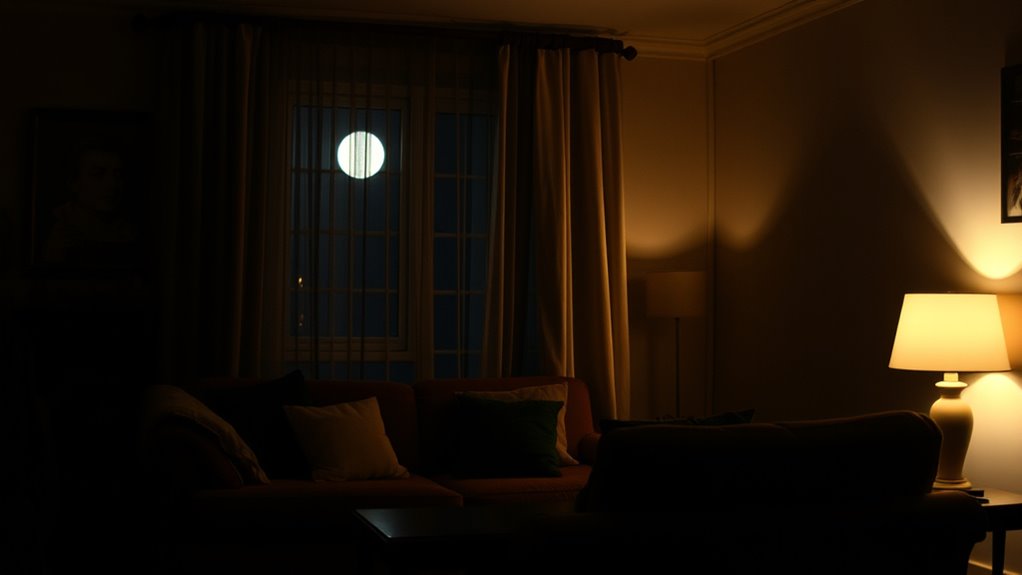
Natural light simply isn’t available at night or in many indoor settings, making artificial lighting essential for clear, well-exposed images. In indoor environments, natural light limitations often mean relying on artificial sources to achieve proper exposure and mood. Walls, furniture, and other obstructions diminish the quality of natural light, requiring supplemental lighting for clarity and detail. Nighttime lighting presents additional challenges, as natural light disappears, making it impossible to depend solely on sunlight. Without enough windows or daylight, images can become underexposed or inconsistent. Artificial lighting helps overcome these constraints, ensuring you can capture sharp, balanced photos regardless of the time or setting. Additionally, the contrast ratio of your lighting setup can significantly influence image depth and clarity, especially in low-light conditions. Relying solely on natural light in these scenarios often results in poor image quality, emphasizing the importance of artificial lighting. Advances in automation and lighting technology have made artificial lighting more adaptable and easier to control, further supporting its necessity in various situations. For example, lighting modifications tailored to specific environments can optimize the quality of your images. Proper light management techniques are essential for achieving consistent, professional results in challenging lighting conditions. Therefore, understanding how to manage light sources effectively is crucial for achieving optimal photograph quality in challenging environments.
Environmental Factors That Affect Natural Light
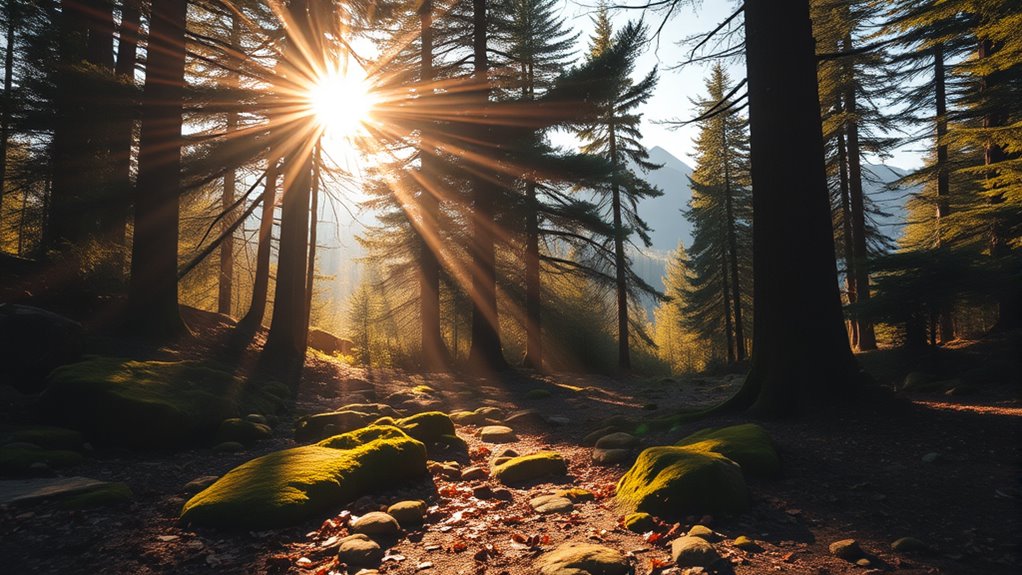
Environmental factors play a pivotal role in shaping the quality and consistency of natural light when you’re outdoors. Cloud cover can diffuse sunlight, creating softer, more even illumination, but heavy clouds can block direct sunlight altogether. Weather conditions like rain, snow, fog, or haze can further mute or diffuse light, reducing visibility and color saturation. Environmental obstructions such as trees, buildings, or mountains cast shadows or block sunlight, making natural light unpredictable and inconsistent. Seasonal changes also influence natural light availability; winter days have shorter daylight hours and lower sun angles, affecting the intensity and warmth of the light. Additionally, the presence of coastal zone structures or materials nearby can reflect or absorb light, further complicating natural lighting conditions. These factors combine to create a variable lighting environment, making natural light less reliable and harder to control in outdoor settings. For instance, urban development can increase shaded areas and alter natural light patterns significantly. Moreover, environmental pollution can also diminish visibility and alter the quality of natural light by scattering particles in the atmosphere. External factors such as air quality can also impact the brightness and clarity of natural light, especially in urban areas with high pollution levels.
Challenges in Achieving Consistent Exposure
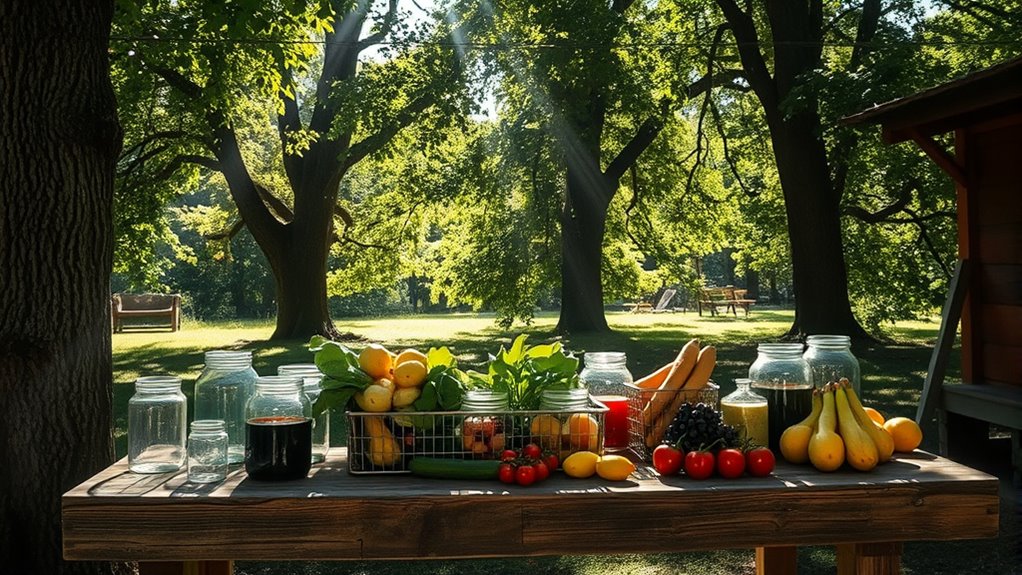
Achieving consistent exposure in outdoor photography is challenging because natural light constantly changes throughout the day. Variations in lighting conditions, like cloud cover or the sun’s position, cause fluctuations in brightness and color temperature. Without artificial modifiers or reflectors, controlling natural light’s intensity and direction becomes difficult, making exposure consistency hard to maintain. You often need to adjust your camera settings—ISO, shutter speed, and aperture—frequently to compensate for these changes. Inconsistent natural light can result in overexposed highlights or underexposed shadows, reducing image quality. Using reflectors can help bounce light and even out lighting conditions, but they don’t eliminate the unpredictable nature of natural light. Additionally, understanding AI-driven analytics can help photographers predict lighting patterns and plan shoots accordingly. Incorporating weather condition forecasts can further improve the ability to anticipate changes in natural lighting. Being aware of weather conditions can further improve the ability to anticipate changes in natural lighting. Employing real-time light meters can also assist in making immediate adjustments during shoots to maintain proper exposure. Incorporating advanced weather forecasting tools can also assist in choosing optimal shooting times and locations.
Weather Conditions and Their Impact on Outdoor Photography
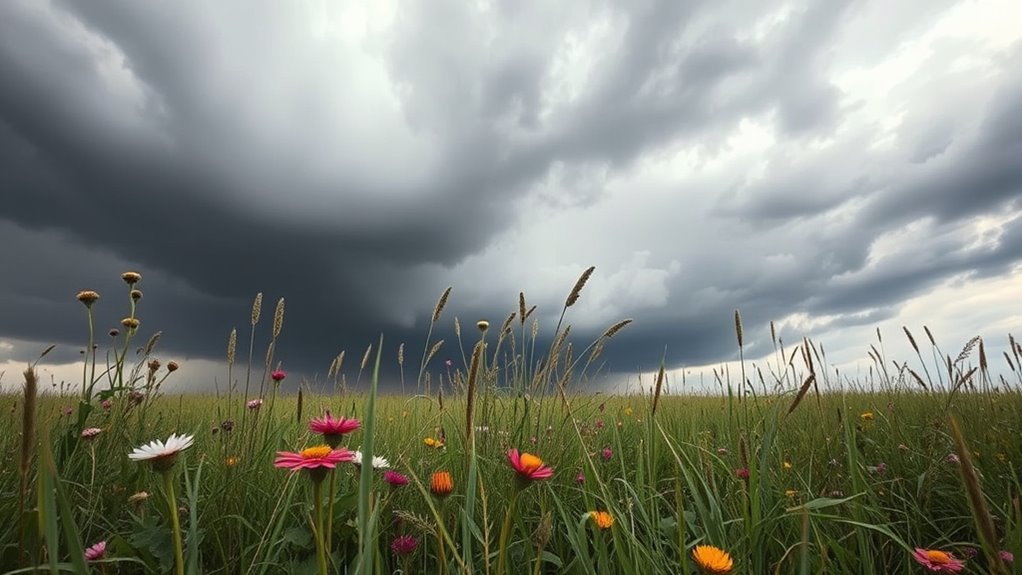
Weather conditions can considerably influence your outdoor photography, often requiring quick adjustments. Overcast days soften light, making portraits more flattering, while bright midday sun can cause harsh shadows and blown highlights. Sudden changes like rain or fog can disrupt your shoot and alter lighting, so staying flexible is key. Incorporating sound healing techniques into your planning can help you stay relaxed and adapt more easily to unpredictable conditions. Additionally, understanding how air quality affects visibility and comfort can help you choose the best times for shooting and prepare accordingly. Advances in AI technology are also increasingly used in weather prediction, helping photographers plan shoots around optimal conditions.
Weather Variability Challenges
Sudden changes in weather can considerably disrupt outdoor photography plans, as clouds roll in or rain begins unexpectedly. Weather variability makes natural light unpredictable, which can create significant lighting challenges during outdoor shoots. Overcast days diffuse sunlight, reducing contrast and making it harder to achieve the desired lighting effects without extra adjustments. The unpredictability of weather can force you to cancel or postpone sessions, leading to lost time and missed opportunities. Additionally, changing weather conditions like wind or snow can cause technical issues, such as equipment instability or lens fogging, impacting image quality. Seasonal and daily weather patterns demand careful planning and flexibility, as ideal natural lighting windows may be brief or inconsistent, complicating your ability to capture the perfect shot under unpredictable conditions.
Lighting and Cloud Cover
Cloud cover profoundly influences outdoor photography by diffusing sunlight, which creates soft, even lighting that minimizes harsh shadows and highlights. When the sky is overcast, cloud cover reduces overall brightness by up to 50%, leading to variable lighting conditions that challenge your exposure settings. You may need longer exposure times or higher ISO to compensate for the dimmer environment. Weather conditions like passing clouds cause fluctuations in light intensity and color temperature, making consistent shots difficult. Thick clouds can block direct sunlight entirely, resulting in low-contrast scenes that might require artificial lighting for clarity. Because weather conditions change rapidly, you must adapt quickly, as natural light becomes less predictable and less controllable. Understanding these effects helps you optimize your camera settings in variable lighting situations.
The Lack of Control Over Natural Light Quality
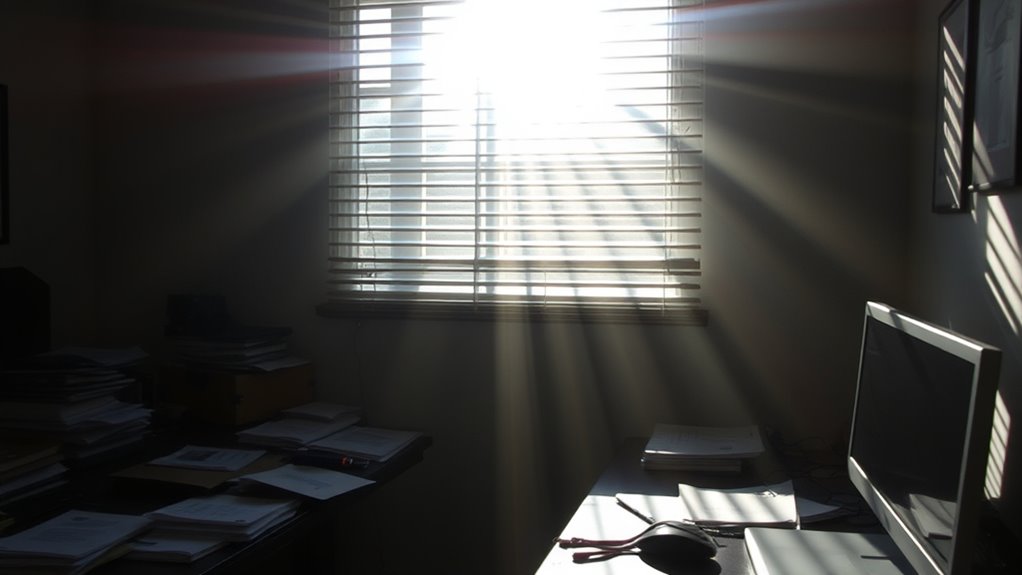
You can’t control how weather changes natural light, which can make your plans unpredictable. The timing of your shoot is limited because natural light shifts throughout the day and seasons. Once you’re started, adjusting exposure or mood based on light becomes nearly impossible.
Weather Variability Challenges
Weather variability poses a significant challenge to maintaining consistent natural light quality, especially in outdoor photography. Sudden changes like cloud cover or haze can drastically alter natural light, making it difficult to achieve uniform images. Overcast skies diffuse sunlight, creating softer light, while clear days cast harsh shadows, resulting in inconsistent lighting. Rapid weather shifts, such as passing storms or changing cloud patterns, force you to adapt quickly or risk ruining shots. Seasonal variations also impact the angle and intensity of natural light, complicating planning for ideal conditions year-round. Environmental factors like pollution, fog, and humidity further degrade natural light quality, adding another layer of unpredictability. This inherent variability makes it tough to rely solely on natural light for consistent, high-quality outdoor photography.
Limited Timing Flexibility
Natural light’s dependence on the time of day, weather, and season considerably limits your scheduling flexibility for outdoor shoots. You can’t control external conditions, so your timing flexibility is constrained by natural factors. For instance:
- The best natural lighting window, like golden hour, lasts only about 30 minutes to an hour.
- Sudden cloud cover or the sun’s position can drastically change lighting conditions, forcing quick adjustments.
- Indoor natural light is limited by window size and orientation, which restricts control over light intensity and direction.
These factors mean you must plan carefully around unpredictable external conditions. Relying solely on natural light often means sacrificing consistent, adjustable lighting, making your scheduling and shoot quality more challenging to manage.
When Natural Light May Not Suit Artistic Goals
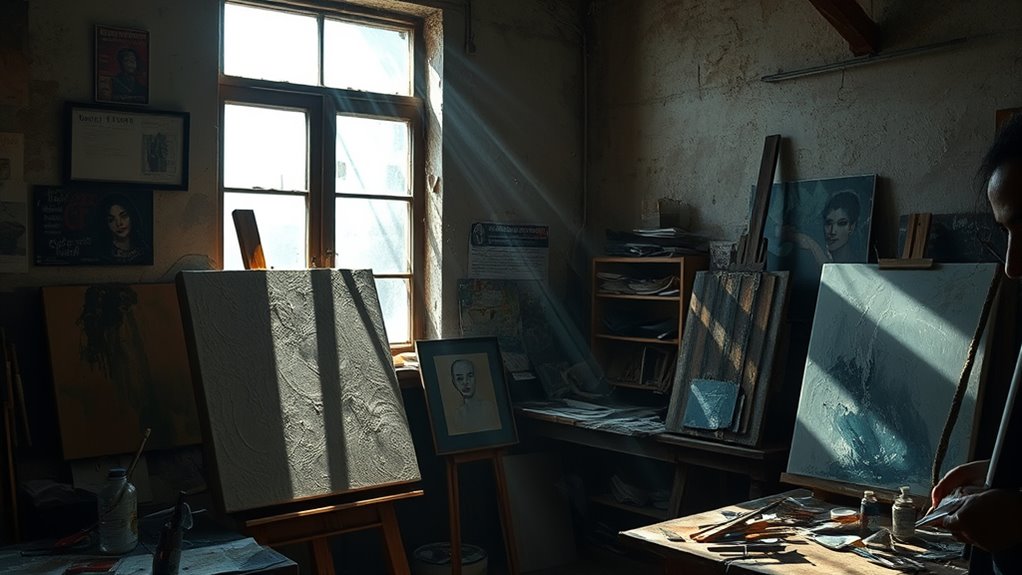
While natural light offers many advantages, it doesn’t always align with certain artistic goals. Its unpredictability can make controlling lighting effects challenging, especially when precise shadows or highlights are needed. Overcast days can produce diffuse, weak light that limits contrast and mood control, while the changing angle and intensity of sunlight throughout the day hinder consistency. Natural light also lacks the flexibility to adjust color temperature, which is vital for achieving specific tones like warm or cool effects. Techniques such as high-key or low-key lighting are difficult to replicate with natural light alone, since its variability makes it hard to maintain uniformity. For these reasons, relying solely on natural light may not suit projects that demand precise control, consistency, and specific artistic visions.
The Cost and Practicalities of Relying Solely on Natural Light
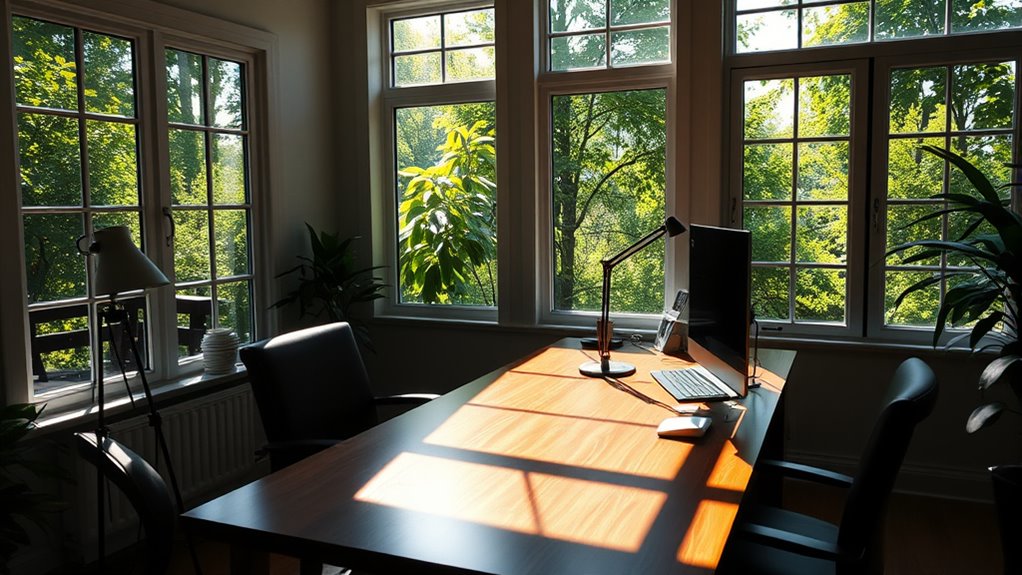
Relying solely on natural light imposes significant restrictions on your shooting schedule, as you can only work during daylight hours. This limits your flexibility and makes planning more complicated. Practicalities like weather can further disrupt your shoot, with clouds, rain, or fog reducing natural light quality or halting outdoor sessions altogether. You also can’t adjust natural light once a shoot starts, making it hard to control shadows, highlights, and exposure. Additional equipment like reflectors or diffusers become necessary, adding costs and complexity. Consider these factors:
- Limited shooting times due to daylight availability
- Unpredictable weather affecting lighting conditions
- Need for extra gear to compensate for natural light’s inconsistency
These practicalities highlight why relying solely on natural light can be challenging and costly.
Situations Where Artificial Lighting Outperforms Natural Light
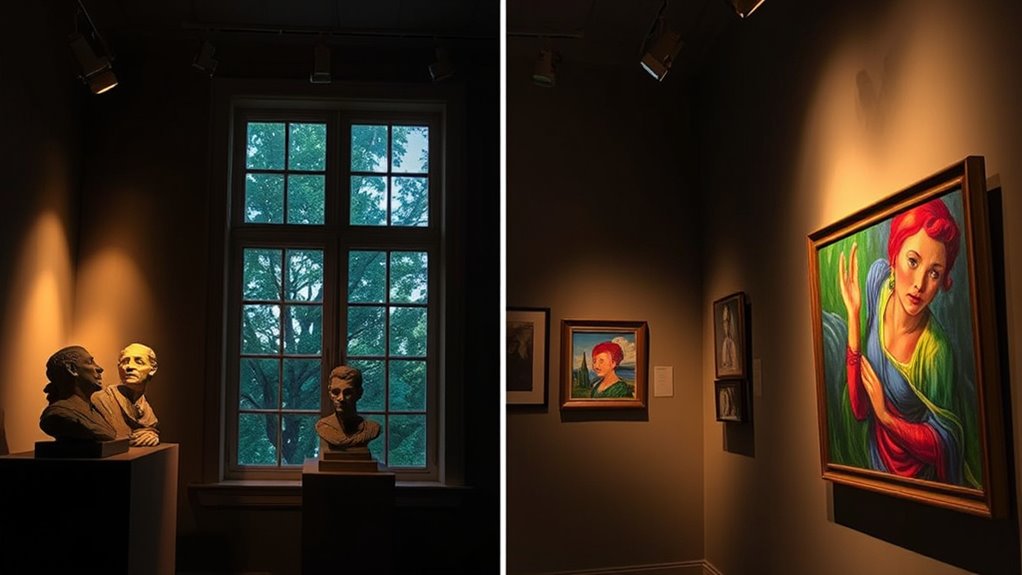
Artificial lighting often outperforms natural light in situations demanding consistency and control. In controlled environments like studios, artificial lighting provides a consistent color temperature and intensity, ensuring uniform results across images. When natural light is insufficient, such as indoors or in low-light settings, artificial sources guarantee proper exposure and detail retrieval. During nighttime or unpredictable weather, artificial lighting allows you to create desired effects reliably, eliminating variables. Additionally, complex creative effects—like precise shadows or specific moods—are easier to achieve with artificial lighting setups that can be manipulated with precision. For commercial or fashion shoots requiring high accuracy and uniformity, artificial lighting consistently outperforms natural light by removing the uncertainties of natural conditions.
Frequently Asked Questions
What Is the Disadvantage of Natural Light?
The disadvantage of natural light is that it’s unpredictable and hard to control. You might face sudden weather changes, cloud cover, or the sun’s position, which can mess up your shoot. Environmental factors like wind or rain can also cause delays or interruptions. Indoors, natural light may be uneven or insufficient, forcing you to use reflectors or extra lighting. Relying solely on natural light limits your consistency and flexibility during photoshoots.
Why Does Natural Light Feel so Much Better?
Like a gentle muse, natural light whispers to your senses, making everything feel more genuine. It casts soft, flattering tones and adds warmth that artificial light struggles to recreate. You feel more connected, as if the scene breathes authenticity. By boosting serotonin and creating subtle color shifts, natural light elevates mood and emotion, making images and moments resonate deeply—like a familiar song that touches your soul.
Why Is Artificial Light Better Than Natural Light?
You might think natural light is always best, but artificial light often surpasses it because of its consistency and control. With artificial lighting, you can set the exact color temperature, brightness, and angle, ensuring your photos look just right every time. Plus, it works indoors or in low-light situations, giving you flexibility and precision that natural light simply can’t provide, making your images more professional and repeatable.
Is Natural Light Flattering?
Imagine you’re taking a portrait on a cloudy day; natural light softens your features and reduces blemishes, making you look more flattering. Natural light can be very flattering, especially during golden hour or in shaded areas, as it creates gentle shadows and highlights. However, harsh midday sun may cause unflattering squinting or uneven lighting. So, natural light is flattering when you choose the right time and conditions.
Conclusion
So, while natural light seems perfect in theory, it’s often unpredictable, fleeting, and out of your control. You chase that ideal glow only to find it’s hiding behind clouds or fading at sunset. Ironically, relying solely on nature’s fickle timing might leave you stuck in the dark—literally. Sometimes, artificial lighting becomes your best friend, offering consistency and control that natural light just can’t provide. After all, isn’t it funny how the most “natural” choice isn’t always the easiest?
